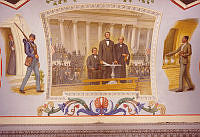Rubenstein Center Scholarship
The Enslaved Households of President James K. Polk
This article is part of the Slavery in the President’s Neighborhood initiative. Explore the Timeline
Like many other slave owning presidents, James K. Polk maintained a different public position on slavery during his presidency (1845-1849) than he expressed privately. In addition to using enslaved labor at the White House, Polk secretly purchased enslaved people and separated children aged ten through seventeen from their families while in office. President Polk projected the persona of a benevolent and paternalistic slave owner who kept enslaved people because they were inherited from family members. In actuality, Polk was a profit-hungry slave owner, ripping apart families for his own personal gain.1
James Knox Polk was born in Pineville, North Carolina, in 1795 to Samuel and Jane Polk. The promise of greater economic opportunities and prosperity drew Samuel Polk and his family westward, and they soon settled just south of Nashville, Tennessee. The western gamble worked out in Samuel’s favor. He became a respected community leader and county judge, instrumental in establishing the county of Maury and town of Columbia, Tennessee.2 He was also a slave owner and businessman. After moving his family to Tennessee in 1806, Samuel established a plantation, where he continued the practice of slavery for the remainder of his life. Upon his death in 1827, Samuel Polk left behind 8,000 acres of land and fifty-three enslaved people to his wife and ten children.3

The White House during the Polk administration. Taken in 1846 by the daguerrean photographer John Plumbe Jr.
Library of CongressJames Polk was heavily influenced by his upbringing on the western frontier and his constant interactions with slavery. These experiences shaped his attitudes toward slavery and westward expansion, as well as his evolution as a slave owner prior to and during his presidency. While Polk had a successful career in politics, serving fourteen years in the House of Representatives and as governor of Tennessee from 1839-1841, he continued to expand his real estate holdings. To shore up his financial security, Polk established a plantation called Somerville in southern Tennessee in 1831, becoming an “absentee planter.”4 Although the plantation enjoyed moderate success, Polk sought additional profit. After Congress passed the Indian Removal Act and President Andrew Jackson forced the Choctaw Nation off their land in northern Mississippi in 1830, one in a series of forced relocations which became known as the Trail of Tears, Polk joined the rush of speculators to purchase the vacant land. He sold his Tennessee plantation and wrote to his wife, Sarah Childress Polk, in 1834: “I am resolved to send my hands to the South, have given money to James Brown to buy the place & have empIoyed Beanland as an overseer. I am determined to make more money or loose [sic] more one.”5 Polk revealed a different side of himself as a slave owner in this letter. He had many issues with runaway slaves at his Somerville plantation, and he believed moving further south to a his new plantation near Yalobusha, Mississippi, would make escape more difficult. Polk chose to keep his decisions secret from his enslaved people, keeping them entirely in the dark about their future: “The negroes have no idea that they are going to be sent to the South, and I do not wish them to know it, and therefore it would be best to say nothing about it at home, for it might be conveyed back to them.”6 Click here to learn more about the enslaved households of President Andrew Jackson.
During the next few years, Polk’s views on slavery continued to evolve. Ultimately, he believed that the federal government did not have the authority to limit the expansion of slavery into western territories. As a young man, Polk had witnessed the benefits enslaved labor brought to landowners in the western territories. He continued to see this benefit through the operation of his own plantations. Although he sometimes expressed concern for enslaved people—on one occasion he fired an overseer after he beat an enslaved man and shot another with birdshot—he generally continued to employ cruel overseers and enslaved people continued to flee his plantation, contradicting his public persona as a benevolent slave owner.7
As Polk ascended politically, he continued to run his plantation from afar. Nonetheless he kept a close eye on profits accrued at the expense of the enslaved people forced to harvest cotton. In Polk’s case, his election to the presidency greatly enhanced his financial position. As Governor of Tennessee, Polk earned just $2,000 for two years of governance. As president, Polk earned $25,000 a year.8 Although he did not directly purchase enslaved people with the money he made as president, his increased salary granted him greater financial freedom. He used his presidential salary to pay off outstanding debts from his presidential campaign, purchase a home in Nashville, buy treasury certificates, and prepare for a comfortable retirement. Meanwhile, he used profits from his Mississippi plantation to purchase an additional nineteen enslaved people during his time in the White House. These enslaved people were purchased through several agents in Tennessee and shipped to Polk’s Mississippi plantation.9

This is a photograph of President James K. Polk's home, Polk Place, in Nashville, Tennessee. He planned to spend his retirement before his early death in June 1849. Polk was originally buried in a tomb pictured in the right hand corner of this photograph before he was moved along with Sarah Polk to the grounds of the Tennessee State Capitol in 1893.
wikimedia commonsDuring his presidency, Polk went to great lengths to keep his purchases of enslaved people secret. If the public had known the extent of his activities as president, there likely would have been a violent outcry. During the 1840s, tensions over the spread of slavery into newly acquired western territories exacerbated sectional divisions between the North and the South, while the abolitionist movement fueled criticisms of slave owners. Several national events occurring during this time period likely encouraged Polk to keep his transactions private.
When Polk first ascended to the presidency in 1845, the House of Representatives had stopped enforcing the “gag rule” only one year earlier. First approved in 1836, while Polk served as Speaker of the House, the resolution barred the discussion of slavery.10 Former president and Massachusetts Representative John Quincy Adams vehemently opposed this rule from its implementation until its repeal in 1844. The passage of the gag rule, and the opposition to it, exacerbated sectional tension within Congress itself.11 Click here to learn more about the enslaved households of President John Quincy Adams.
In 1846, President Polk instigated the Mexican-American War, a two-year conflict stemming from the 1845 annexation of Texas. After the federal government annexed Texas during Polk’s first year in office, he sent American diplomat John Slidell to secretly negotiate a dispute over Texas’ boundary claims and purchase the territories of New Mexico and California for up to thirty million dollars. When Mexican President José Jaoquín Herrera turned Slidell away, instead of pushing for further diplomacy, President Polk ordered American troops under General Zachary Taylor to occupy disputed territory, inciting the conflict.12

Pennsylvania Avenue looking northwest, from a perch on Capitol Hill, around the time of the Mexican-American War. Washington’s crowded “main street” stretches to the White House (dimly visible on the left).
National Archives and Records AdministrationWhile the war was raging, the House of Representatives introduced the Wilmot Proviso in August 1846, which would have banned slavery in territory acquired during the Mexican-American War.13 Historian William Dusinberre argues that Polk likely considered the expansion of slavery into western territories as he pursued war with Mexico in 1846.14 Although the Wilmot Proviso was ultimately defeated in the Senate in 1847, Polk opposed this Proviso, promising that he would veto if it managed to pass the Senate. He personally believed that slave owners had the constitutional right to take their enslaved people wherever they went and that any threat to this right jeopardized their freedom as citizens. In a draft message prepared for the veto of the provision, Polk stated: “the blessings of liberty may be put in jeopardy or lost forever.”15
Just days after the House of Representatives adopted the Wilmot Proviso, President Polk sent a letter to his cousin and slave-purchasing agent, Robert Campbell: “the reasons why, it should not be known to any one but him and yourself that you are making the purchases for me. There is nothing wrong [in] it, but still the public have no interest in knowing it, and in my situation it is better they should not.”16 This letter clearly demonstrates Polk’s uncomfortable balancing act. Although he personally supported slavery and received political report from southerners and westerners as the President of the United States, he also had to consider the growing antislavery sentiment and the recent successes of the abolitionist movement. With the expansion of slavery on the line, President Polk decided to play his cards close to the vest to prevent additional public scrutiny.
In addition to the volatile national tensions over slavery, there was another important reason Polk was keen on keeping his purchases private. Out of nineteen enslaved people purchased by Polk during his presidency, at least thirteen were children. Throughout 1846, Polk purchased eight enslaved children: Jane (12-13), Sally (~ 12), Agnes (13), Calvin (~13), Caroline Henly (16), William (17), Jim (14), and an unidentified enslaved boy (14).17 Three years later, as Polk prepared to leave office, he again engaged in the purchase of enslaved children, instructing his agent to remain silent on the matter: “This letter is for your eyes alone...to buy me some property for my Yalobusha plantation.” He also instructed the purchase of enslaved people aged twelve to twenty-one.18

In purchases started during Polk’s final weeks in office and finalized just after he left Washington, four more children were purchased: Jerry (10), Anderson (11), Jason (11), and Rosetta (16). From these transactions, it is clear that Polk did not object to purchasing young children under the specified age of twelve. During these transactions he also purchased two women over the age of eighteen: Caroline Davis (19) and Caroline Harris (20).19
Why would President Polk purchase enslaved children? Polk and many others preferred to purchase children because they could work harder for longer periods of time, and in the eyes of a slave owner, their youth meant better financial returns on investment. In addition, these young enslaved people would eventually have children of their own, therefore increasing the population of Polk’s plantation and providing a continuing source of free labor. It appears that all of these individuals were separated from their families upon purchase. The threat of family separation always loomed for enslaved people, and it could come at any moment. Although their thoughts on the matter were not recorded, it must have been particularly wrenching for some of the younger purchased children, like ten-year-old Jerry.
Only one of the enslaved children did not have to experience separation from his family. In 1846, Polk purchased an enslaved man named Harbert that he had previously sold to a man named Gideon J. Pillow in 1840 after Harbert became “unruly and unmanageable.”20 Sarah Polk was reluctant to sell Harbert because he was inherited from her family and wanted to buy him back several years later. When Polk wrote to Pillow about purchasing Harbert, he stated, “If Harbert has a wife or a wife and children I have authorized him to purchase them also, as I would be unwilling to separate them.”21 Although Pillow was initially reluctant to part with Harbert and his family, he consented to sell Harbert, with his wife and seven-year-old son, back to Polk for $1,450.22 This transaction suggests that Polk did not like separating families if he had a long term, established relationship with the enslaved family in question.

This is a photograph of Paul Jennings by the E.C. Perry Photograph company. Jennings' owner was none other than Dolley Madison. Jennings worked in the Madison White House and was later hired out by Dolley Madison, who was at that point in dire need of financial assistance, to President Polk in 1845, collecting all of Jennings' wages for herself.
The Estate of Sylvia Jennings AlexanderIn addition to his purchase of enslaved individuals during his time as president, Polk also used enslaved labor to run his presidential household. At least four enslaved individuals worked in the James K. Polk White House. One of these enslaved people was a young man named Henry Carter, Jr. His parents, Henry Carter, Sr. and Mariah, were valued by James and Sarah Polk despite their enslavement. Polk purchased Henry Carter, Sr. in 1834 while he was developing his new plantation in Mississippi. At the time he was already married to an enslaved woman named Mariah, who was inherited by Sarah Polk. In an act of goodwill, that was also an advantageous economic decision, Polk purchased Henry Carter, Sr. from a nearby plantation owner to prevent his separation from Mariah, writing to Sarah Polk about the transaction: “I bought Mariah’s husband a very likely boy—about 22 years old for $600 and paid for him with the notes I held on his master for land which I sold him several years ago.”23 The Henry Carter, Sr. certainly lived up to Polk’s expectations, becoming a strong and valued worker. In 1846, he was the most successful laborer on Polk’s Mississippi plantation, earning seventy percent more than any other enslaved person. It is likely, the advantageous position of Henry Carter’s parents, placed him in a privileged position as well.24
Instead of staying behind to work at either Polk’s Tennessee or Mississippi properties, like most of Polk’s enslaved people, the Henry Carter, Jr. accompanied the president and first lady to Washington, D.C. Documentation confirms that he worked in the President’s House from 1847-1849, but it is likely he was with Polk throughout his presidency. Henry Carter, Jr. was likely the only enslaved household servant consistently attached to Polk’s presidential household. However, his duties and position in the President’s House remain unclear. Although Polk kept a diary and regular correspondence throughout his presidency, he rarely mentioned the day-to-day operations of the presidential household. When he is mentioned in Polk’s diary, he is described simply as “servant.”25

Elias Polk also worked in the Polk White House. Prior to his time in the White House, Elias had been gifted to James as a wedding present by Samuel Polk in 1824 and had served the Polks for many years. Although he likely worked at the White House in 1845, Polk also hired Elias out to a man named James H. Thomas from late 1845 through 1846. Elias rejoined the presidential household in 1847, and then left Washington with the Polks for their Tennessee home in 1849. After gaining his freedom following the Civil War, Elias established himself as a political leader in Tennessee. Surprisingly, for a man freed from slavery, Elias politically aligned himself with white southern elites and the Democratic Party.
A third enslaved man named Paul Jennings was also hired out to work in the White House for a brief time period in the spring of 1845. Paul Jennings’ owner was none other than Dolley Madison, and he had worked in James Madison's presidential household from 1809 through 1817. In 1845, in dire need of financial assistance, former First Lady Dolley Madison hired Jennings out to President Polk, collecting Paul’s wages for herself. This arrangement was temporary, as she later sold Jennings to an insurance agent named Pollard Webb.26 Click here to learn more about the enslaved households of President James Madison.

This is an image of Elias Polk from the Daily American newspaper, published in Nashville, Tennessee on December 31, 1886.
The President James K. Polk Home & Museum, Columbia, TennesseeAn entry in Polk’s diary from March 5, 1849, mentions an enslaved woman named Milly. As he prepared to depart Washington, D.C. for retirement after the swearing in of President Zachary Taylor, Polk recorded the following: “I take with me also my servant (Henry) & Milly, a maid servant belonging to J. Knox Walker.”27 Since Walker was Polk’s nephew and private secretary, it is likely she worked within the Polk White House. In addition, historian Amy S. Greenberg asserts that Milly was married to Henry Carter, further tying her to the household.28 Click here to learn more about the enslaved households of President Zachary Taylor.
James K. Polk did not have the chance to enjoy a comfortable retirement at Polk Place in Nashville. Ultimately, his preparation and purchase of enslaved men, women, and children to create a profitable retirement only benefitted First Lady Sarah Polk. On June 15, 1849, just four months after leaving office, a cholera outbreak in Nashville claimed the former president.29 However, the legacy of slavery carried on. Sarah Polk continued to run their Mississippi plantation and Polk Place before and during the Civil War. In fact, she refused to flee Polk Place during the war and continued to portray herself as a model southern, Christian woman, all while hosting Union soldiers.30 Meanwhile, on her Mississippi plantation, at least ten enslaved people left the property upon the arrival of Union forces on August 19, 1863. Seven of Mrs. Polk’s enslaved people went on to serve in the Union Army, fighting for their freedom and four million others who remained in forced bondage.31










